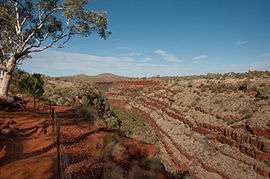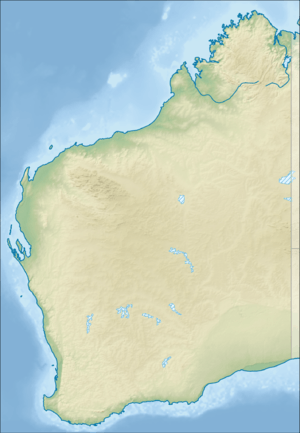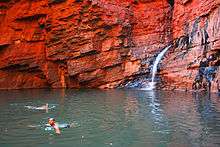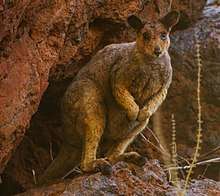Karijini National Park
Karijini National Park is an Australian national park centred in the Hamersley Ranges of the Pilbara region in the northwestern section of Western Australia. The park is located north of the Tropic of Capricorn, 1,055 kilometres (656 mi) from the state's capital city, Perth. Formerly known as Hamersley Range National Park, the park was officially renamed in 1991.[3]
| Karijini National Park Western Australia | |
|---|---|
IUCN category II (national park) | |
 Dales Gorge | |
 Karijini National Park | |
| Nearest town or city | Tom Price |
| Coordinates | 22°29′46″S 118°23′50″E |
| Established | 1969 |
| Area | 6,274.22 km2 (2,422.5 sq mi)[1] |
| Visitation | 166,000 (in 2009)[2] |
| Managing authorities | Department of Parks and Wildlife (Western Australia) |
| Website | Karijini National Park |
| See also | List of protected areas of Western Australia |
At 627,422 hectares (1,550,390 acres), Karijini is the second largest national park in Western Australia (behind Karlamilyi National Park).
The park is physically split into a northern and a southern half by a corridor containing the Hamersley & Robe River railway and the Marandoo iron ore mine.[4]
The park is served by the Solomon Airport, located 15 kilometres (9.3 mi) to the west.
History
A party led by explorer F.T. Gregory explored the area in 1861. He named the Hamersley Range, on which the park is centred, after his friend Edward Hamersley.
Climate
The park is located in the Pilbara region, and is mostly tropical semi-arid climate. In summer, thunderstorms and cyclones are common, bringing 250–350 mm of rain annually.[5] Temperatures on summer days frequently exceed 40 degrees Celsius, while winter nights can bring frost.
Geology
Several gorges that flow north out of the park—including Dales, Kalamina, Wittenoom and Yampire Gorges—provide notable displays of the rock layers:[6][7]
Fauna
The park's wildlife includes red kangaroos, euros, rock-wallabies, echidnas, geckos, goannas, bats, legless lizards and a large variety of birds and snakes, including pythons.[14]
Features

The park is most notable for its many gorges containing slot canyons, waterfalls and water holes with visitors sometimes swimming in the cold pools of water.[15]
Hamersley Gorge is located in the northwestern region of the park, while Range Gorge is in the north, Munjina Gorge is in the east, and Hancock, Joffre, Knox, Red and Weano Gorges converge in the park's center.[16]
While the park is fully open to the public, visitors are warned to exercise due caution when walking in and around the vicinity of Yampire and Wittenoom Gorges near the northern boundary of the park due to the presence of blue asbestos—a known cancer-causing agent when inhaled—which occurs in a number of the rock formations.[1]
References
- "Australia's North West › Pilbara › Karijini National Park › Welcome (tab)". Explore Parks WA. Department of Parks and Wildlife. 2013. Archived from the original on 4 November 2016. Retrieved 4 November 2016.
- ABC: Karijini National Park visitor numbers drop, 13 October 2010
- Department of Conservation and Land Management; National Parks and Nature Conservation Authority (1999). "Karijini National Park Management Plan No. 40" (PDF). Government of Western Australia. p. 1. Archived from the original (PDF) on 12 March 2011. Retrieved 25 June 2014.
- Australia Road and 4WD Atlas, publisher: HEMA maps, published: 2007, page: 86-87
- M. Bright, 1001 Natural Wonders You Must See Before You Die, Quintet Publishing, London 2005
- Thorne, Alan (2003) Geology of the Gorges DEC
- MacLeod, W. N. (1966) The geology and iron deposits of the Hamersley Range area. Bulletin (Geological Survey of Western Australia), No. 117,http://henrietta.liswa.wa.gov.au/record=b2251313~S2 Archived 4 March 2016 at the Wayback Machine -
- "Archived copy". Archived from the original on 23 October 2012. Retrieved 7 August 2012.CS1 maint: archived copy as title (link)
- http://www.portergeo.com.au/tours/iron2002/iron2002depm1.asp
- http://dbforms.ga.gov.au/pls/www/geodx.strat_units.sch_full?wher=stratno=20327
- http://www.fish.wa.gov.au/docs/pub/AquaGroundWater/pilbara.php?9999
- http://www.physorg.com/news110122626.html
- Webb Adam D., Dickens Gerald R., Oliver Nicholas H. S. (2004). "Carbonate alteration of the Upper Mount McRae Shale beneath the martite-microplaty hematite ore deposit at Mount Whaleback, Western Australia". Mineralium Deposita. 39 (5–6): 632–645. doi:10.1007/s00126-004-0434-z.CS1 maint: multiple names: authors list (link)
- "Karijini National Park – Beyond The 26th". ABC. Archived from the original on 24 November 2007. Retrieved 19 December 2006.
- "Karijini National Park". westernaustralia.com. Archived from the original on 8 September 2006. Retrieved 19 December 2006.
- "Karijini National Park Visitor guide" (PDF). Explore Parks WA (note: PDF file link appears in "Downloads & Resources" tab of webpage: parks.dpaw.wa.gov.au/park/karijini). Department of Parks and Wildlife. 2016. Archived (PDF) from the original on 4 November 2016. Retrieved 4 November 2016.
Further reading
- Padgett, Allan (1991) Karijini National Park – description of some of the more remote gorges. Landscope, Vol. 7, no. 1 (Spring 1991), pp. 16–21
External links
![]()
